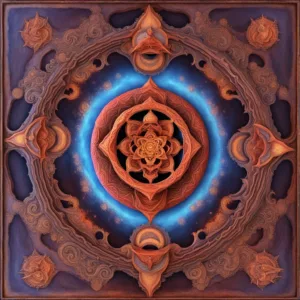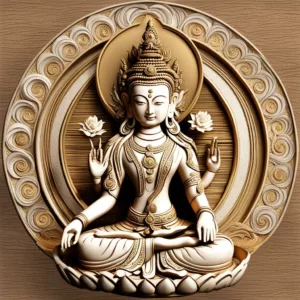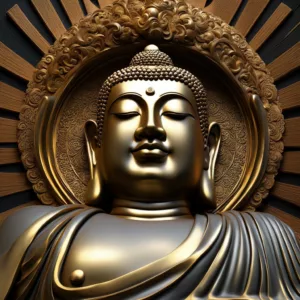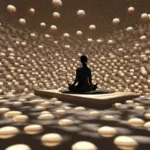Meaning and 21 powerful mudras to Heal and Focus
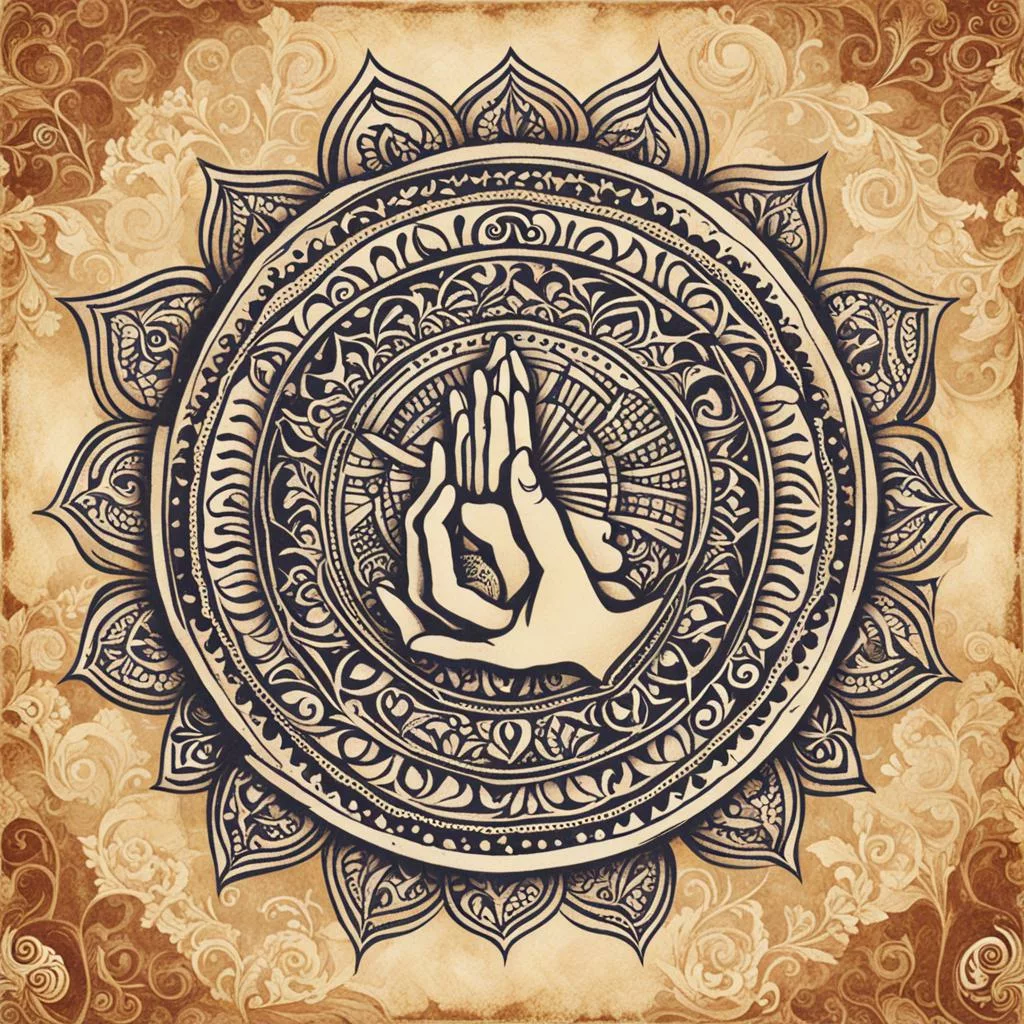
Mudra, meaning ‘seal’, is a way to represent reality or meditative object by gesture. Done properly with good samadhi, due to shunyata, the mudra becomes the reality for the mindstream.
Table of Contents
List of Mudras Most Used
| Mudra Name | Meaning |
|---|---|
| Anjali Mudra | Salutation, prayer, respect |
| Gyan Mudra | Wisdom, knowledge |
| Varun Mudra | Fluid balance, hydration |
| Chin Mudra | Concentration, meditation |
| Prana Mudra | Vital energy, life force |
| Apana Mudra | Detoxification, elimination |
| Hakini Mudra | Memory enhancement, concentration |
| Dhyana Mudra | Meditation, contemplation |
| Shuni Mudra | Patience, discipline |
| Surya Mudra | Energy, metabolism |
| Buddhi Mudra | Mental clarity, communication |
| Matangi Mudra | Openness, intuition |
| Shambhavi Mudra | Inner balance, focus |
| Bhairava Mudra | Grounding, stability |
| Lotus Mudra | Enlightenment, purity |
| Vayu Mudra | Air element balance, calming |
| Rudra Mudra | Transformation, powerful energy |
| Kubera Mudra | Manifestation of desires, abundance |
| Linga Mudra | Creative energy, spiritual awakening |
| Ganesh Mudra | Overcoming obstacles, courage |
| Hridaya Mudra | Activation of the heart center, love and compassion |
Summary: Mudra
| Entity | Description |
|---|---|
| Mudra | A symbolic hand gesture or posture used in spiritual practices |
| Religions/Practices | Hinduism, Buddhism, Jainism, Yoga |
| Purpose | * Focus attention * Channel energy * Represent symbolic meaning * Enhance meditation or prayer |
| Types | Hand gestures (hasta mudras), body postures (kaya mudras), eye gazes (drishti mudras) |
| Examples | * Chin Mudra (thumb and index finger touching) * Jnana Mudra (thumb and index finger forming a ring) * Anjali Mudra (palms together at heart center) * Lotus Mudra (hands placed on lap, palms facing up) |
| Significance | * Can deepen meditation or prayer * Symbolic representations can vary by tradition * Often used with mantras or visualizations |
| Additional Notes | * Extensive variety of mudras exist * May have different meanings or interpretations depending on context * Often learned from a qualified teacher |
Mudra: additional details, related terms
LSI Keywords for Mudra
General Terms:
- Hand gesture
- Symbolic posture
- Spiritual practice
- Meditation aid
- Yoga posture (asana)
- Energy flow
Types of Mudras:
- Hasta Mudras (hand gestures)
- Kaya Mudras (body postures)
- Drishti Mudras (eye gazes)
Specific Mudras:
- Chin Mudra
- Jnana Mudra
- Anjali Mudra
- Lotus Mudra
- Yoni Mudra
- Shambhavi Mudra
- Hakini Mudra
- Vajra Mudra
- Namaste Mudra
Benefits:
- Improved focus and concentration
- Increased energy flow
- Deeper meditation or prayer
- Enhanced relaxation
- Symbolic connection to spiritual concepts
Related Practices:
- Meditation
- Yoga
- Pranayama (breathwork)
- Mantra recitation
- Visualization
Additional Terms:
- Chakras (energy centers)
- Prana (life force)
- Mantra (sacred syllable or phrase)
- Asana (yoga posture)
- Mudra variations (by tradition)
- Qualified teacher (for proper instruction)
Secrets of Meditation for Anxiety
Like millions of people, you may have suffered from anxiety for years. Meditation, yoga, peaceful music – it never works. It takes too long, and it’s not stable. Why? Because peace is treated as a cause for freedom, but it’s not – it’s the result. The cause to free yourself from anxiety is completely different.
Click now to Overcome Anxiety for good.
List of Mudra pictures pdf
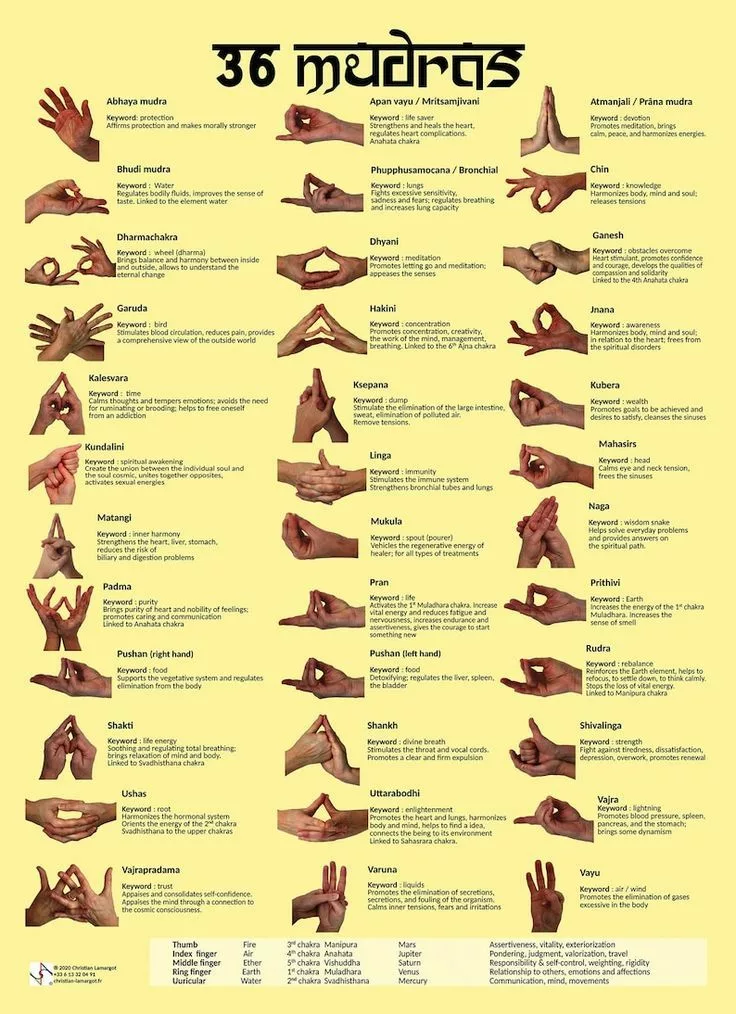
Mudras Meaning
Mudras, derived from the Sanskrit word for “seal” or “gesture,” hold profound meanings across various spiritual and cultural traditions. These symbolic hand gestures are employed to channel energy within the body, mind, and spirit. In essence, mudras convey specific intentions, representing connections to universal energies or archetypal qualities. The meanings can range from promoting inner peace and concentration to invoking healing energy or deepening one’s spiritual awareness. The subtle yet intentional positioning of fingers and palms in mudras carries symbolic significance, facilitating a direct link between the physical body and the metaphysical aspects of consciousness.
Mudras Buddhism
Jamgon Mipham, one of the greatest teachers in Buddhist history, said that each mudra was an enlightened entity.
In Buddhism, mudras play a significant role as spiritual tools to enhance meditation, concentration, and mindfulness. These hand gestures are often integrated into the practices of Buddhist monks and practitioners worldwide. Mudras in Buddhism serve as a means of expressing specific aspects of the Buddha’s teachings, channeling energy during meditation, and symbolizing various qualities such as compassion, wisdom, and enlightenment.
The iconic image of the Buddha with hands forming specific mudras is a visual representation of profound spiritual truths. For example, the Dhyana Mudra, with hands resting in the lap, symbolizes meditation and the attainment of inner calm. Understanding mudras in the context of Buddhism deepens one’s connection to the spiritual aspects of the tradition, fostering a holistic approach to personal and collective well-being.
Mudras with Names
A rich tapestry of mudras exists, each with its unique name and significance. From the commonly practiced Anjali Mudra, symbolizing respect and gratitude, to more esoteric gestures like the Linga Mudra, representing the cosmic energy within, mudras with names carry diverse meanings and applications. The Chin Mudra, with the index finger touching the thumb, signifies the connection of individual consciousness with the universal. Exploring the myriad mudras with names provides practitioners with a nuanced understanding of their potential benefits and the cultural or spiritual contexts from which they originate. This comprehensive exploration allows individuals to tailor their mudra practice to address specific intentions, whether seeking focus, tranquility, or spiritual elevation.
Mudra Yoga
In the realm of yoga, mudras are integral components of the practice, complementing physical postures and breath control techniques. Mudra yoga involves the intentional use of these hand gestures to deepen the meditative and spiritual aspects of the practice. Yogic mudras are often seamlessly integrated into pranayama (breath control) and meditation sessions, enhancing the overall mind-body connection. The synergy of mudra yoga lies in the alignment of the physical gestures with the breath and consciousness, creating a holistic approach to self-awareness and spiritual development. Incorporating mudras into yoga practice enriches the transformative journey of yoga, fostering balance, focus, and a heightened sense of presence.
Mudras List
A comprehensive mudras list encompasses a multitude of gestures, each carrying unique meanings and benefits. This list serves as a valuable resource for practitioners seeking to expand their repertoire of hand gestures for specific purposes. From healing mudras like the Prana Mudra, associated with vital life force energy, to empowerment gestures such as the Shakti Mudra, practitioners can explore a diverse range of mudras to suit their individual needs. A mudras list acts as a guide, offering a glimpse into the vast array of hand gestures available, allowing individuals to experiment with and incorporate various mudras into their daily practices for physical, mental, and spiritual well-being.
Mudras for Healing
Mudras for healing form a specialized category, focusing on the therapeutic potential of specific hand gestures. These mudras are believed to stimulate energy channels, balance the body’s vital forces, and promote overall wellness. For instance, the Apana Mudra, involving specific finger placements, is associated with detoxification and elimination of waste from the body. Exploring mudras for healing provides individuals with tools to address specific health concerns and enhance their overall vitality. The intentional practice of healing mudras integrates seamlessly into holistic well-being approaches, complementing other healing modalities and promoting a sense of harmony within the body and mind.
Mudra Benefits
Mudras, or hand gestures, have been integral to various spiritual and healing traditions for centuries. These symbolic gestures, often practiced in meditation or yoga, are believed to facilitate the flow of energy within the body, influencing physical, mental, and spiritual well-being. The benefits of mudras extend beyond mere hand movements, encompassing a holistic approach to health and self-awareness.
The subtle yet profound effects of mudras include promoting relaxation, enhancing concentration, and balancing the flow of vital energy, also known as prana or chi. Practitioners assert that regular engagement with mudras can lead to an improved sense of overall well-being.
Mudra Anxiety
In the fast-paced and often stressful modern world, managing anxiety has become a common concern. Mudras offer a complementary approach to conquer anxiety by calming the mind and redirecting nervous energy. Specific mudras, such as the Gyan Mudra and Varun Mudra, are known for their anxiety-reducing effects. Incorporating these gestures into mindfulness practices can provide a sense of grounding and tranquility.
Mudra in Yoga
Yoga, an ancient practice that integrates physical postures, breath control, and meditation, frequently incorporates mudras as a means of deepening the mind-body connection. Mudras in yoga serve as tools to enhance concentration, channel energy, and foster a meditative state. Whether practiced individually or in conjunction with yoga poses, mudras contribute to the holistic benefits of a yoga practice.
Power Mudra
Certain mudras are considered potent sources of energy and are often referred to as “power mudras.” These gestures are believed to activate specific energy centers or chakras within the body, amplifying the flow of prana. The Hakini Mudra, for instance, is associated with enhancing memory and concentration, making it a power mudra for mental clarity. Exploring and incorporating power mudras into one’s routine can bring about heightened awareness and vitality.
List of Mudras with Pictures
The vast array of mudras encompasses a diverse range of hand positions, each with its unique symbolism and benefits. A visual guide in the form of a list of mudras with pictures can be a valuable resource for practitioners. This visual reference aids in understanding the correct hand placement and the intended effects of each mudra. From simple gestures like the Anjali Mudra (prayer pose) to more intricate ones like the Shankh Mudra (conch shell gesture), a comprehensive list with images enhances accessibility for individuals exploring mudras for the first time.
108 Mudras PDF
For those seeking an in-depth exploration of mudras, a comprehensive guide such as a “108 Mudras PDF” can be a valuable asset. This document typically details a wide range of mudras, providing insights into their cultural, spiritual, and therapeutic significance. A 108 Mudras PDF offers a wealth of information for practitioners looking to deepen their understanding and incorporate a variety of mudras into their daily routine.
Gyan Mudra
The Gyan Mudra, one of the most commonly practiced mudras, involves bringing the thumb and index finger together, forming a circle while keeping the other fingers extended. This mudra is associated with wisdom, knowledge, and the expansion of consciousness. Regular practice of the Gyan Mudra is believed to enhance concentration, improve memory, and foster a receptive state of mind.
Hand Mudra
The term “hand mudra” encompasses a broad category of gestures involving specific arrangements of the fingers and palms. Hand mudras can be used for various purposes, including meditation, healing, and invoking specific qualities or energies. Each hand mudra has a distinct significance, and the choice of mudra depends on the intention behind the practice.
In conclusion, mudras offer a fascinating exploration of the profound connection between hand gestures and overall well-being. From the Gyan Mudra for wisdom to power mudras that energize the body, these hand gestures have diverse applications in both spiritual and therapeutic contexts. The benefits of mudras extend beyond the physical realm, influencing mental and spiritual dimensions. Whether utilized for anxiety reduction, incorporated into yoga practice, or explored through a list of mudras with pictures, the world of mudras invites individuals to deepen their understanding of the subtle energies at play within the body and mind.

May all beings be happy
May all beings be peaceful
May all beings be safe
May all beings awaken to the light of their true nature
May all beings be free


